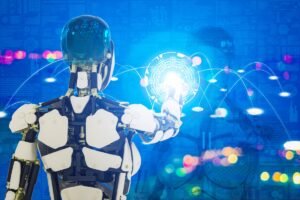In this article, we will read deeply into how autoencoders work, their applications, and why they are essential for today’s AI systems. In the world of artificial intelligence (AI), autoencoders are an unsung hero. While large language models like GPT often make the headlines, autoencoders have quietly been enabling a wide range of applications. From improving storage efficiency to enhancing AI model performance, autoencoders play a crucial role in AI’s success.
Table of Contents
What are Autoencoders?
Autoencoders are a type of neural network that emerged in the 1980s and gained popularity through Geoffrey Hinton’s work in 2006. At their core, autoencoders are designed to compress data, learn efficient representations, and then reconstruct the original data. The model consists of two key components:
- Encoder: This part of the model takes input data (like an image) and compresses it into a smaller, more manageable format, known as a “latent representation.”
- Decoder: The decoder takes this compressed data and tries to reconstruct the original input as closely as possible.
By going through this process, autoencoders learn how to represent data in a way that makes it easier to store, process, and interpret. Think of it like packing your belongings in a smaller suitcase just as you carefully organize your items to fit the limited space, autoencoders learn how to condense large data into a smaller format.
Read More What Are Generative Adversarial Networks (GANs)? A Complete Beginner’s Guide
Why Autoencoders Are So Important
Autoencoders are used for many reasons, with two of the most important being noise reduction and feature extraction.
1. Noise Reduction
One of the key benefits of autoencoders is their ability to reduce noise in data. Whether it’s in images, text, or any other type of data, autoencoders can filter out irrelevant information. By learning to ignore unnecessary details, AI models become more efficient and accurate in their predictions.
2. Feature Extraction
Autoencoders are also excellent at identifying the most important features within data. For example, when processing images, autoencoders can focus on the most relevant parts of an image (like faces or objects) while ignoring the less important details. This makes AI models more precise, as they can learn from the most critical information.
Common Applications of Autoencoders
Autoencoders are widely used across different AI fields. Here are some of the most popular applications:
1. Recommendation Systems
Ever wondered how Netflix seems to know exactly what you want to watch next? Autoencoders play a key role in recommendation systems. By analyzing user preferences and behavior, autoencoders learn efficient representations of users and their interests. This allows platforms like Netflix to predict what movies or shows you might enjoy based on past behavior.
Why This Matters: The efficiency of autoencoders makes it possible for recommendation systems to process large amounts of user data without overwhelming servers, leading to faster and more accurate recommendations.
2. Anomaly Detection
Autoencoders are also used in detecting anomalies, especially in the financial sector. Financial data often follows predictable patterns, so autoencoders can learn these patterns and flag anything that deviates from them.
For example, in credit card fraud detection, if a transaction looks very different from typical user behavior, the autoencoder can flag it as suspicious. This helps identify fraudulent activities before they cause major damage.
3. Natural Language Processing (NLP)
In NLP, autoencoders are used for tasks like text summarization and translation. They can condense long text into shorter, meaningful representations, making it easier to translate or summarize text without losing critical information.
4. Image Processing
Autoencoders are also crucial in image processing tasks, particularly for denoising. They can remove noise from images, improving image quality. Additionally, they help with dimensionality reduction, making large image datasets easier to handle during training.
5. Data Compression
Autoencoders can efficiently compress data, which is particularly useful for storage and transmission. By reducing the size of data without losing important information, they allow companies to save on storage costs and increase the speed of data processing.
How Autoencoders Are Used in AI
Autoencoders are foundational in many AI systems. Their ability to reduce noise and extract key features makes them highly valuable for improving the performance of machine learning models. They help in tasks ranging from image recognition to natural language understanding. When applied to complex tasks like anomaly detection or recommendation systems, autoencoders ensure that models are both accurate and computationally efficient.
Read More What Is a Transformer Network Model in AI 2025?
FAQs About Autoencoders work
Q. What is an autoencoder in machine learning?
Ans. An autoencoder is a type of neural network that is trained to map input data to a smaller representation (encoding) and then reconstruct the input from this smaller representation. It’s commonly used for data compression, noise reduction, and feature extraction.
Q. How do autoencoders reduce noise in data?
Ans. Autoencoders learn to ignore irrelevant information in data and focus on the key features. This helps them filter out noise, making the data cleaner and more useful for further analysis.
Q. What are the real-world applications of autoencoders?
Ans. Autoencoders are used in many areas, including recommendation systems (like Netflix), anomaly detection (e.g., credit card fraud), image processing (e.g., denoising), and natural language processing tasks like summarization and translation.
Q. Can autoencoders be used for unsupervised learning?
Ans. Yes, autoencoders are typically used for unsupervised learning. They learn to compress and reconstruct data without needing labeled examples, making them ideal for scenarios where labeled data is scarce.
Conclusion
Autoencoders are a powerful and versatile tool in the AI landscape. From improving recommendations on your favorite streaming platform to detecting fraudulent financial activities, they help make AI models smarter and more efficient. As AI continues to evolve, autoencoders will undoubtedly remain an essential building block for many innovative applications.





Pingback: The Spiking Neural Networks (SNNs) in 2025
Pingback: Transforming AI with Neural Architecture Search NAS in 2025